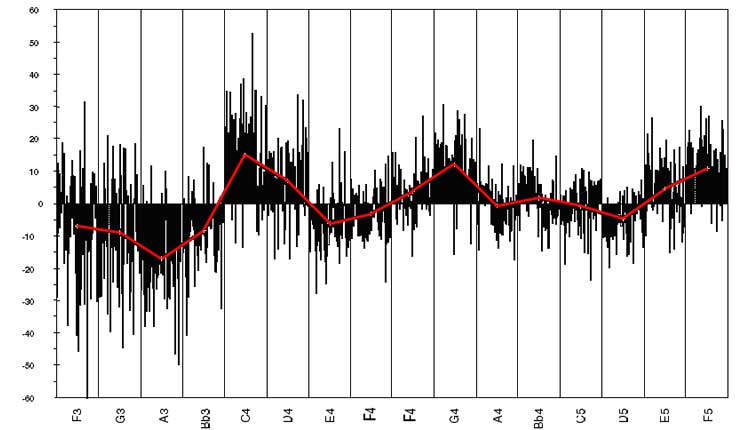Associate Professor of Music
Stephen F. Austin State University
(Some of the concepts addressed below are trumpet specific, some relate to all brass instruments, and yet others are applicable to all musicians.)
Two important steps to playing in tune:
- Know if you’re out of tune. Listen. If pitch is bad, assume it could be you. Being first chair does not mean you cannot be out of tune, just as having perfect pitch does not mean you have perfect intonation. Everyone must take responsibility for adjusting intonation to fit the group of musicians with whom they are playing.
- Adjust. Don’t just sit there. If you don’t know which way to go, try up or down. If it gets worse, go the other way.
Knowing your pitch tendencies will allow you to make an educated guess as to which direction you are probably out of tune.
Pitch Tendencies:
Valve combinations:
1 + 2 = sharp (use first slide).
2 + 3 = flat (lip up, absolutely no slide).
1 + 3 = sharp (use third slide).
1 + 2 + 3 = very sharp (use first and third slide).
The harmonic series:
Fifth harmonics are flat (lip up 4th line D, 4th space E-flat, and E).
Sixth harmonics are sharp (lip down high G and F-sharp, thumb slide on F).
Seventh harmonics are unusuably flat.
Environmental temperature:
cold = flat; hot = sharp
The colder or hotter, the flatter or sharper.
Condition of the trumpet:
Very dirty = smaller bore = sharp
Immovable slides = inability to adjust = sharp
Sound quality, dynamic level, and distance:
It is only possible to play in tune with a good, centered sound.
Loud playing tends to go flat, or is at least perceived as flat.
Soft playing tends to go sharp, or is at least perceived as sharp.
Playing at a distance makes the pitch go flatter to the listener, therefore if you are playing from backstage you must push in.
Miscellaneous equipment issues:
- Mutes make you go sharp, so pull out. Each type of mute will differ, so check yours with a tuner. Filing the corks can adjust a mute’s pitch to a degree.
- Tuners only work as a reference. You can be in tune with a tuner and out of tune with everyone else.
- The shallower the mouthpiece, the sharper you will play.
Embouchure and tongue position:
- The tighter your embouchure, the sharper you will play, and the looser the flatter.
- The higher your tongue is arched in your mouth, the sharper you will play ( a good means of “lipping up”), and the lower the flatter. The concept of adjusting your tongue arch in order to change pitch and tone quality is often referred to as “voicing.”
Equal versus Just intonation:
- Equal temperament is playing 100 cents per half step, like with a tuner. This is the way a piano is tuned.
- Just intonation is adjusting to make intervals and chords “beatless.” As wind instrumentalists we have the ability to accomplish this.
Here are the places where you should begin to do this (with relation to the root):
M3 Narrow by 14 cents
m3 Widen by 16 cents
P4 Narrow by 2 cents
P5 Widen by 2 cents
m7 Narrow by 4 cents
You must know your place in the chord to accomplish this task.
Gary Wurtz has been the trumpet professor at SFA since the fall of 1992, and began his duties as Jazz Band director one year later. His other duties at SFA include directing the Trumpet Ensemble and performing in the Pineywoods Brass Quintet.
This article is reprinted with permission from the Texas School Music Project web site (http://www.tsmp.org). This site is sponsored and produced by the music faculty at Stephen F. Austin State University with the purpose of providing practical information for public school educators, students, and all interested musicians.


